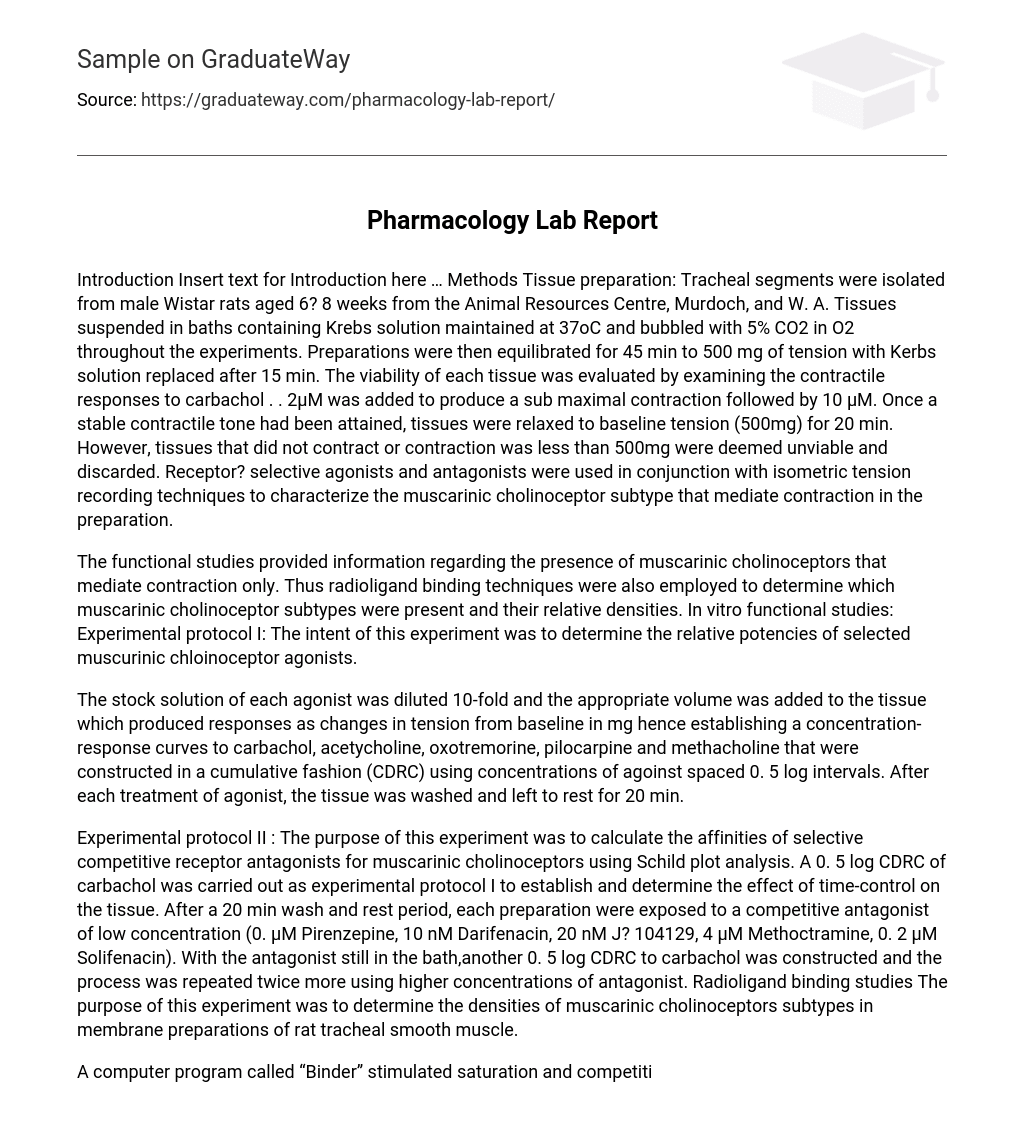Introduction Insert text for Introduction here … Methods Tissue preparation: Tracheal segments were isolated from male Wistar rats aged 6? 8 weeks from the Animal Resources Centre, Murdoch, and W. A. Tissues suspended in baths containing Krebs solution maintained at 37oC and bubbled with 5% CO2 in O2 throughout the experiments. Preparations were then equilibrated for 45 min to 500 mg of tension with Kerbs solution replaced after 15 min. The viability of each tissue was evaluated by examining the contractile responses to carbachol . . 2µM was added to produce a sub maximal contraction followed by 10 µM. Once a stable contractile tone had been attained, tissues were relaxed to baseline tension (500mg) for 20 min. However, tissues that did not contract or contraction was less than 500mg were deemed unviable and discarded. Receptor? selective agonists and antagonists were used in conjunction with isometric tension recording techniques to characterize the muscarinic cholinoceptor subtype that mediate contraction in the preparation.
The functional studies provided information regarding the presence of muscarinic cholinoceptors that mediate contraction only. Thus radioligand binding techniques were also employed to determine which muscarinic cholinoceptor subtypes were present and their relative densities. In vitro functional studies: Experimental protocol I: The intent of this experiment was to determine the relative potencies of selected muscurinic chloinoceptor agonists.
The stock solution of each agonist was diluted 10-fold and the appropriate volume was added to the tissue which produced responses as changes in tension from baseline in mg hence establishing a concentration-response curves to carbachol, acetycholine, oxotremorine, pilocarpine and methacholine that were constructed in a cumulative fashion (CDRC) using concentrations of agoinst spaced 0. 5 log intervals. After each treatment of agonist, the tissue was washed and left to rest for 20 min.
Experimental protocol II : The purpose of this experiment was to calculate the affinities of selective competitive receptor antagonists for muscarinic cholinoceptors using Schild plot analysis. A 0. 5 log CDRC of carbachol was carried out as experimental protocol I to establish and determine the effect of time-control on the tissue. After a 20 min wash and rest period, each preparation were exposed to a competitive antagonist of low concentration (0. µM Pirenzepine, 10 nM Darifenacin, 20 nM J? 104129, 4 µM Methoctramine, 0. 2 µM Solifenacin). With the antagonist still in the bath,another 0. 5 log CDRC to carbachol was constructed and the process was repeated twice more using higher concentrations of antagonist. Radioligand binding studies The purpose of this experiment was to determine the densities of muscarinic cholinoceptors subtypes in membrane preparations of rat tracheal smooth muscle.
A computer program called “Binder” stimulated saturation and competition binding experiments on virtual, homogenised rat tracheal preparations that were radio-labelled with [3H]? QNB and contained a cold ligand. The settings were set to ‘Non? specific binding’, ‘Noise in the data’ and ‘Noise in the ligand concs’. For the Total binding curves the cold ligand was set to zero. Results Insert text for Results here … Discussion Insert text for Discussion here … Acknowledgements Insert text for Acknowledgements here …
References Insert References here … ———————– RESEARCH PAPER The Characterisation of Muscurinic Cholinoceptor Subtypes as a Potential Drug Target for COPD Faheema Adat Molecular Pharmacology 3301, School of Medicine and Pharmacology, University of Western Australia, Australia, 6009. Background and purpose: Experimental approach: Key results: Conclusions and implications: Keywords: Abbreviations: ______________________________________________________________________________________________





